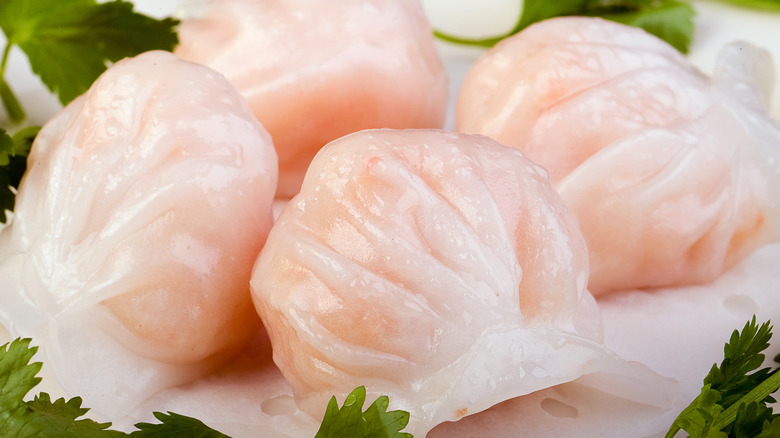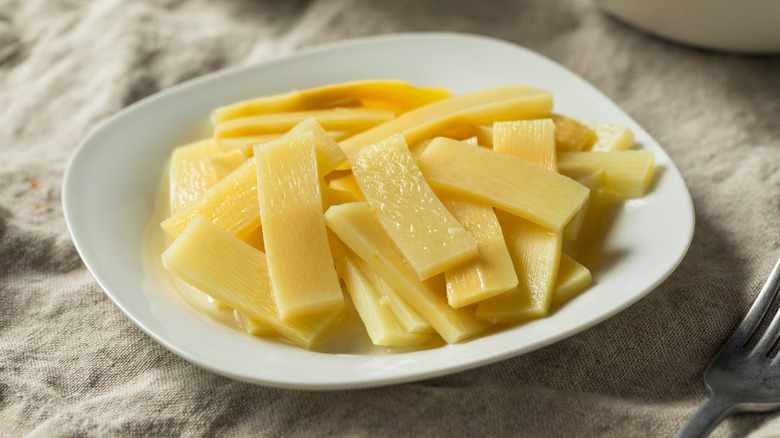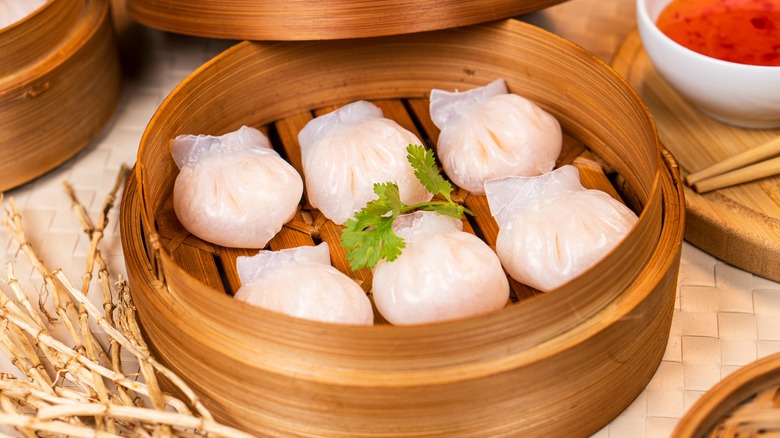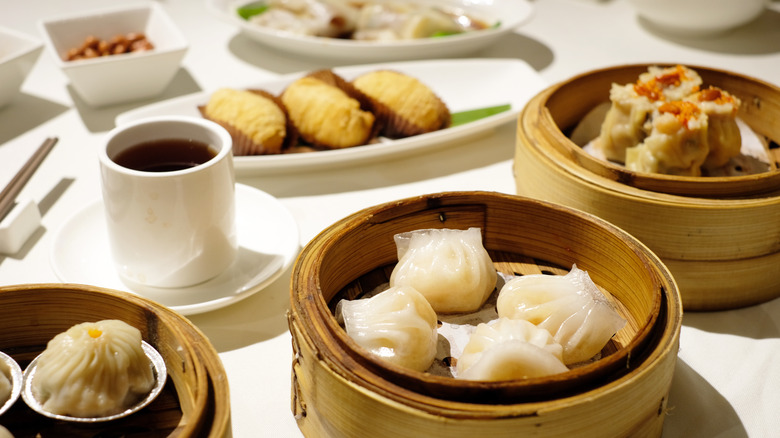Har Gow: The Delicate Shrimp Dumplings That Are A Dim Sum Staple
If you've ever experienced the pleasure of having dim sum, you'll know that what makes it fun is the variety of dumplings you get to share with the table. Among the usual picks of pork and shrimp siu mai dumplings, Chinese sticky rice (lo mai gai), and cha siu bao, you'll find a gorgeous, glassy pink dumpling: har gow. Created in a tea house in Guangzhou about a century ago, this shrimp dumpling eventually became one of the most famous types of dim sum to be enjoyed during yum cha or Chinese tea.
Unlike most dumplings, har gow is enveloped in a glassy, chewy skin that reveals the succulent shrimp inside, which is why some call it crystal shrimp dumplings. In flavor, har gow is far more simple than its dim sum counterparts, highlighting the juicy shrimp filling. Every bite will give you a burst of shrimp along with the chew of the starchy wrapper. So what makes this seemingly simple dumpling so special?
What goes in har gow?
While the main ingredient in har gow is always shrimp, there are also finely minced ginger and bamboo shoots that add bits of crunch throughout. While the ginger adds an herbaceous spice to the filling, bamboo shoots offer a nutty flavor and texture.
White pepper, a mainstay in Chinese cuisine, is a more subtle, less smoky version of black pepper. While black pepper can interrupt the pale appearance of shrimp paste, white pepper dissolves right into it so that you hardly notice that it's there. There's also a drizzle of sesame oil added in, which infuses the dumpling with the earthy and toasted aroma of sesame and helps to bind the filling ingredients together.
There's also a bit of oyster sauce involved, which is a dark brown sauce with a deep salty and earthy flavor and a hint of sweetness, making it a classic umami additive. Even with oyster sauce, it's always necessary to add salt and sugar separately to have greater control of each flavor component. Some har gow recipes even add starch to the filling to make it more sticky and cohesive and to maintain the shrimp's smooth texture.
Lastly, har gow wouldn't be itself without the iconic translucent wrapper, which is arguably the most challenging aspect to get right when making the dish. The wrapper is made from a mix of wheat starch and tapioca flour, which gelatinizes once steamed.
How har gow is made
Preparing the shrimp filling is a straightforward process. First, you have to chop through the flesh of the shrimp until it reaches a paste-like consistency — although you can add a large piece of shrimp to give it a fuller bite. Some mash the shrimp paste with one side of a cleaver to further break it down. Then you must finely mince your ginger and bamboo shoots into small pieces. Combine the ingredients of the filling with white pepper, oyster sauce, sesame oil, salt, and sugar, and let it sit in the fridge to let them bind as they settle.
The har gow wrapper is made from hot water dough, which comes together with boiling water and fat. First, add all the starches, salt, and fats to a mixing bowl, and then gradually add boiling water as you stir. The boiling water should dissolve starch, giving har gow its signature clear appearance. You continue to knead the dough until it becomes one mass, adding starch to the work surface to make it less sticky.
The texture should be pliable yet firm, so you can shape it into a dumpling wrapper. You can utilize the cleaver for this process, pressing the dough ball while rotating to keep the skin even. All that's left to do is to stuff these wrappers with shrimp filling, fold them, and steam them until they're clear and the shrimp has visibly turned pink.
Where to get har gow
Almost every dim sum spot should have har gow on the menu since it is a mainstay in Cantonese cuisine. Because perfecting the gelatinous wrapper at home can be pretty tricky, it might be easier to order some at your nearest dim sum joint. If you're adamant about tackling this dish at home, there are premade har gow flour mixtures you can buy online that make it easier to build the dough. Some recommend using rice paper, commonly used for Vietnamese spring rolls. Of course, the rice paper will not yield the same texture, but it will achieve a similarly glassy appearance and chew.
Given the popularity of frozen dumplings and dim sum, har gow can also be found in the freezer section at many Asian grocery stores. The romanization for har gow varies — some are labeled hacao, haukau, har gao, and ha gow — so be sure to look out for these names since they all refer to the same shrimp dumpling. The only thing you need to do is steam these frozen dumplings or even microwave them until the wrapper turns clear.



